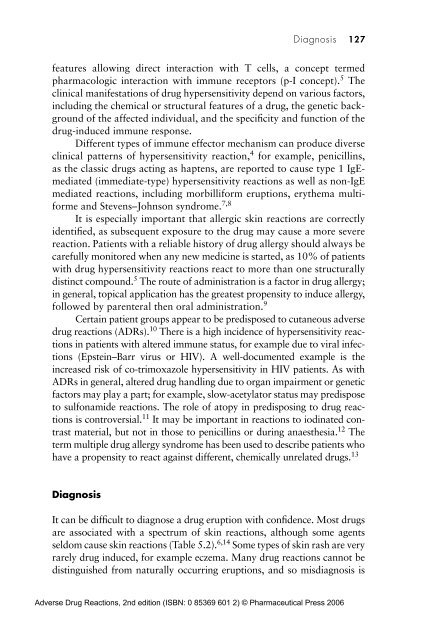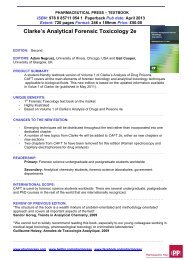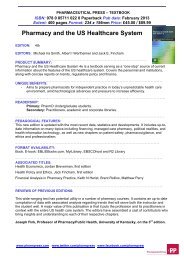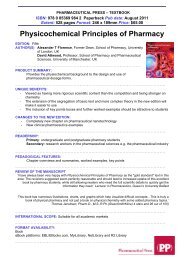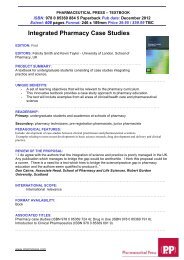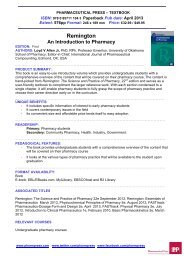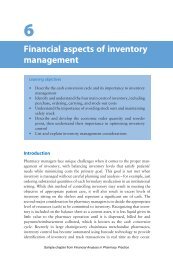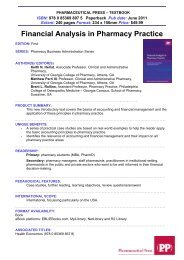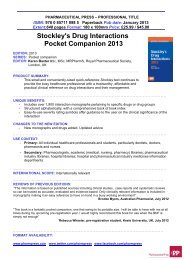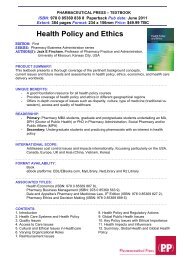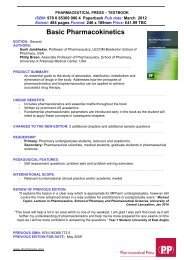Drug-induced skin reactions - Pharmaceutical Press
Drug-induced skin reactions - Pharmaceutical Press
Drug-induced skin reactions - Pharmaceutical Press
You also want an ePaper? Increase the reach of your titles
YUMPU automatically turns print PDFs into web optimized ePapers that Google loves.
Diagnosis 127<br />
features allowing direct interaction with T cells, a concept termed<br />
pharmacologic interaction with immune receptors (p-I concept). 5 The<br />
clinical manifestations of drug hypersensitivity depend on various factors,<br />
including the chemical or structural features of a drug, the genetic background<br />
of the affected individual, and the specificity and function of the<br />
drug-<strong>induced</strong> immune response.<br />
Different types of immune effector mechanism can produce diverse<br />
clinical patterns of hypersensitivity reaction, 4 for example, penicillins,<br />
as the classic drugs acting as haptens, are reported to cause type 1 IgEmediated<br />
(immediate-type) hypersensitivity <strong>reactions</strong> as well as non-IgE<br />
mediated <strong>reactions</strong>, including morbilliform eruptions, erythema multiforme<br />
and Stevens–Johnson syndrome. 7,8<br />
It is especially important that allergic <strong>skin</strong> <strong>reactions</strong> are correctly<br />
identified, as subsequent exposure to the drug may cause a more severe<br />
reaction. Patients with a reliable history of drug allergy should always be<br />
carefully monitored when any new medicine is started, as 10% of patients<br />
with drug hypersensitivity <strong>reactions</strong> react to more than one structurally<br />
distinct compound. 5 The route of administration is a factor in drug allergy;<br />
in general, topical application has the greatest propensity to induce allergy,<br />
followed by parenteral then oral administration. 9<br />
Certain patient groups appear to be predisposed to cutaneous adverse<br />
drug <strong>reactions</strong> (ADRs). 10 There is a high incidence of hypersensitivity <strong>reactions</strong><br />
in patients with altered immune status, for example due to viral infections<br />
(Epstein–Barr virus or HIV). A well-documented example is the<br />
increased risk of co-trimoxazole hypersensitivity in HIV patients. As with<br />
ADRs in general, altered drug handling due to organ impairment or genetic<br />
factors may play a part; for example, slow-acetylator status may predispose<br />
to sulfonamide <strong>reactions</strong>. The role of atopy in predisposing to drug <strong>reactions</strong><br />
is controversial. 11 It may be important in <strong>reactions</strong> to iodinated contrast<br />
material, but not in those to penicillins or during anaesthesia. 12 The<br />
term multiple drug allergy syndrome has been used to describe patients who<br />
have a propensity to react against different, chemically unrelated drugs. 13<br />
Diagnosis<br />
It can be difficult to diagnose a drug eruption with confidence. Most drugs<br />
are associated with a spectrum of <strong>skin</strong> <strong>reactions</strong>, although some agents<br />
seldom cause <strong>skin</strong> <strong>reactions</strong> (Table 5.2). 6,14 Some types of <strong>skin</strong> rash are very<br />
rarely drug <strong>induced</strong>, for example eczema. Many drug <strong>reactions</strong> cannot be<br />
distinguished from naturally occurring eruptions, and so misdiagnosis is<br />
Adverse <strong>Drug</strong> Reactions, 2nd edition (ISBN: 0 85369 601 2) © <strong>Pharmaceutical</strong> <strong>Press</strong> 2006


